The pros and cons of MarketMan are demonstrated by a capable automated ordering system, powerful inventory feature, multi-user and multi-location support, and integrations with third-party applications. It comes with a nifty cookbook module, but the mobile version could use better implementation.
Customers have decreased, supplies have become scarce, your order and delivery services have all moved online, your fixed expenses like rent, electricity, and water costs have gone up, and your restaurant branches have become inconsistent in the food they serve your customers. This is an all-but-real scenario that happened to the entire restaurant business during the pandemic lockdowns.
How does one remain profitable in these challenging economic times? One clear solution is to migrate your back-end and some front-end operations to the cloud and to mobile apps. Indeed, many restaurants have done this and shifted to offsite ordering and delivery services. In-house or onsite dining has decreased because of social distancing regulations, and generally the refusal of workers to work under hazardous COVID conditions. Restaurant management software has helped struggling enterprises and made them more profitable in no time.
In this review, we will look at some of the features that have enabled many small businesses and large enterprises to survive and even thrive during a pandemic in our recommended software platform, MarketMan. This article aims to guide you through the pros and cons of MarketMan software for restaurant management and inventory management usage.

Pros & Cons of MarketMan Table of Contents
The food industry has drastically changed because of the COVID-19 pandemic, which has driven the increase in ghost kitchens and food ordering through apps and online sites. Onsite dining and food pick ups by customers have all decreased significantly, instead shifting online. It is estimated that the online food delivery market size worldwide is $130.2 billion, with the number of online food delivery users worldwide forecast to reach at 1.6 billion. This has become such a lucrative venture, with a forecast average revenue per online food delivery user worldwide of $89.10.
It is even surprising that restaurants that survived the pandemic are now facing another threat—inflation. The US Bureau of Labor Statistics has published some statistics on the price increases of several food group products for 2022. Inflation has caused the prices of many basic food groups to increase by at least 7% to 16%, and this might be a continuing trend in the next few years. With this trend, restaurants and ghost kitchens are in a tight bind and will be forced to work their way around already-slim margins in the food service industry.
2022 12-month percent change in the Consumer Price Index for All Urban Consumers, USA
*not seasonally adjusted
Cereals and bakery product: 16.1
Cereals and bakery product
Dairy and related products : 15.3
Dairy and related products
Nonalcoholic beverages and beverage materials : 12.6
Nonalcoholic beverages and beverage materials
Fruits and vegetables: 8.4
Fruits and vegetables
Other food at home : 13.9
Other food at home
Meats, poultry, fish, eggs: 7.7
Meats, poultry, fish, eggs
Source: U.S. Bureau of Labor Statistics, 2023
Designed byIn many cases, independent chains have the size and scale to lock in prices for ingredients from suppliers, and they often receive better contracts, but managing supplies and inventory that may become seasonal in availability and fluctuate in price is difficult to do without utilizing restaurant management software applications.
MarketMan Overview

MarketMan is a leading cloud-based platform designed for restaurant management, inventory management, and supplier/vendor management for restaurants or ghost kitchens. Its flexible restaurant POS (point-of-sale) integrations and a wide variety of functions make it perfect as an overall business platform for small to big restaurants, food service ventures, and any company in the food and beverage industry. These include fully-centralized commissary kitchens, quick service restaurants (QSRs), full-service restaurants (FSRs), catering services, coffee shops, cafes, and even private or personal chefs who cater to specific food niche markets.
The software can also be used by suppliers to manage their entire product catalogs online, and also by restaurant’s business partners to help reduce and save on costs related to food waste. What sets it apart from other solutions is its completeness as a food service company software platform—it possesses features that require little to no need for other software modules from other vendors to manage your food and beverage business.
The following are key features of MarketMan:
- Recipe costing and management
- Multiple API integrations
- Delivery tracking
- White-label phone app
- Costing and accounting features
- Robust inventory management features
- Supplier live pricing updates
- Order Notifications
- Restaurant Auditing Features
- Analytics and Custom Reports
- User-authentication Access Control
- Automatic Digital Cookbook Generation
Detailed MarketMan Review
The major benefits of using this software are its centralization of finance-related functions that make it easy to manage your costs and revenue, flexibility in managing your operations from anywhere through cloud and mobile device access, and the convenience of its many automated features, including a recipe and menu management system.
Some of its key features and functions include powerful inventory management, purchasing and ordering management, expense tracking, management of multiple business units and chains, a cookbook feature, and recipe costing software. All of these features make for a complete package that serves as a single comprehensive solution for your restaurant business needs.
Integration with major customer relations management, accounting, and workflow management platforms can be conveniently done through MarketMan’s API, which allows for programming and scripting access. Seamless communication and program integration make it easy and straightforward to incorporate MarketMan into your organization’s overall systems platform, adding a powerful software system to your company’s tools.
MarketMan easily integrates with accounting software such as QuickBooks, which allows for quick and accurate accounting and cash flow calculations of your entire restaurant or food service business. The restaurant management platform also boasts great native mobile support for iOS and Android phones, tablets, and other devices and allows access to your back-end data in the cloud from anywhere 24/7 and all year round.
The software is available in several pricing packages: the Operator package starting at $152/month/location, the Professional package at $211/month/location, and the Ultimate package starting at $339/month/location. All of these packages can be enhanced with extra add-ons with variable costs depending on your needs. The vendor offers a free trial.
Pros and Cons of MarketMan Software
1. Ease of Use and Setup
MarketMan software has a very clean and intuitive interface that looks identical in both its mobile app and the desktop program. Since it is cloud-based, it will work on any browser, though it works faster on its native mobile app than on a mobile browser. It is very easy to use, with table and list displays of the information you need. It also displays key statistics and analytics in dashboards that are easy to read and understand.

MarketMan sports a clean and intuitive interface for desktop and mobile apps.
2. White Label Mobile App
Quite unique to MarketMan is its white-label capabilities that your company can use without any reference to MarketMan. This allows your own restaurant or ordering app to capture and match the look and feel of your own brand. You can place your own custom-branded app on mobile app stores (iOS and Android OS) using your own brand name and your own rules. You can advertise your company services under your own app built upon MarketMan’s technology, with no programming on your part.
This will benefit your vendors, suppliers, and customers as they can conveniently browse through your app, offer your dynamic pricing for product offerings, help you optimize and schedule deliveries, browse through your entire product catalog, place orders, and make mobile payments all through their mobile devices.
3. Cloud-Based Data Access
The cloud is the modern standard for most application platforms, and its many benefits include access from anywhere, real-time automated data updates, real-time data analytics, and a centralized location for all company data and information. It handles all back-end operations and is accessible via any mobile or desktop device.
However, it may also be one of the cons of restaurant management—the user will have to come to terms with the fact that all restaurant and customer data will be copied to and from worldwide servers with no direct control of data access by hackers or third parties. Of course, cloud hosting companies all use high-grade security and privacy, but ultimately, putting trust in cloud services is the main decision of the user organization. It is notable that most businesses have already moved their operations to cloud-based services either partially or fully.
4. Powerful Inventory Management
Inventory management is essential to costing and profitability. As with dedicated inventory management tools, the software allows you to track what comes in and out of your kitchens, bar, and office from food ingredients and supplies, wines and alcoholic beverages, to non-food items such as cutlery and glassware, and other essentials. The cloud-based system allows for real-time tracking at all times so you can monitor costs, profits, and even losses due to waste or theft.
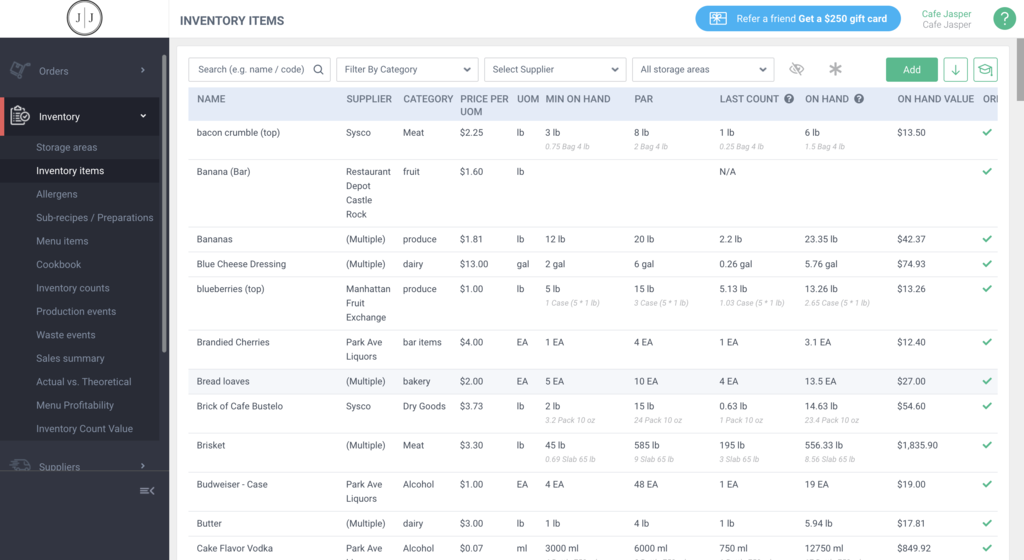
MarketMan allows you to track what comes in and out of your kitchens, bar, and office—from food ingredients and supplies.
Handling your inventory efficiently can also help you spot opportunities for better and more local suppliers who can get you better products with shorter wait times.
5. Automated Ordering System
For seasonal ingredients, supplies can become scarce really quick, and how fast you can order from a supplier with limited stocks can make or break your menu offerings. It is very time-consuming and error-prone to make orders and clarifications via numerous phone calls or emails, and manual data entry is slow and unreliable.
You can automate all these in the software easily, giving you complete control over what to order, which suppliers to order from, what time, what amounts, and what kind of shipping or transport is needed for your orders. It is also easy to track your order and supplier history, making it easy to identify reliable suppliers and the products they deliver to your restaurant in the past.
All these can be done within a budget you specify and adhere to. Another technique to save on costs is to order fewer ingredients from suppliers or to order in bulk, which the software handles easily.
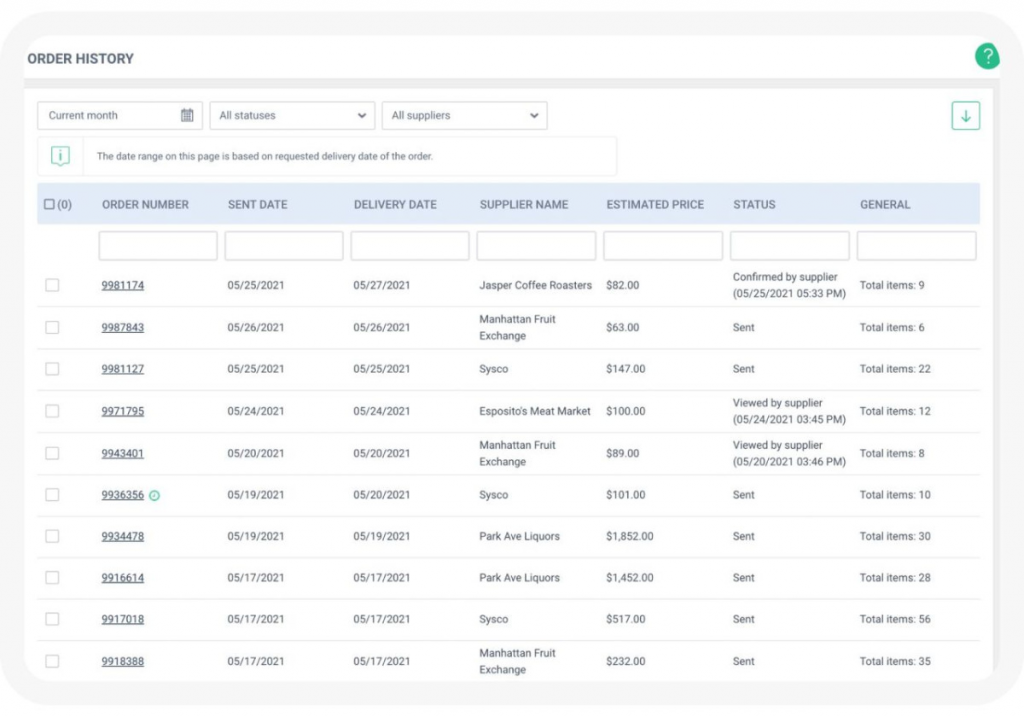
With MarketMan, you can automate all orders within budget easily, giving you complete control over what to order.
You can also automatically manage exact delivery schedules and ordering cut-off times to make ordering more efficient. Programming order reminders help everyone stay on top of all your restaurant’s ingredient requirements and ordering schedules.
It has been reported that some supplier and pricing updates may not be accurate, but this information mainly depends on prevailing daily market prices and factors dictated by supply and demand and is not a limitation of the software.
6. Analytics and Reports for Performance Tracking
As the growing importance of data analytics software shows, tracking specific statistics will help you improve your overall restaurant performance and the overall dining experience of your customers. How much time on average does meal preparation and cooking time take for each menu item, and how much time elapses between customer orders? How long does it take for typical diners to order, eat, pay, and leave? How long does a diner have to wait before getting a seat in your restaurant, at different branches? Minimizing these and all in-between waiting times can help reduce indoor dining turnaround times.
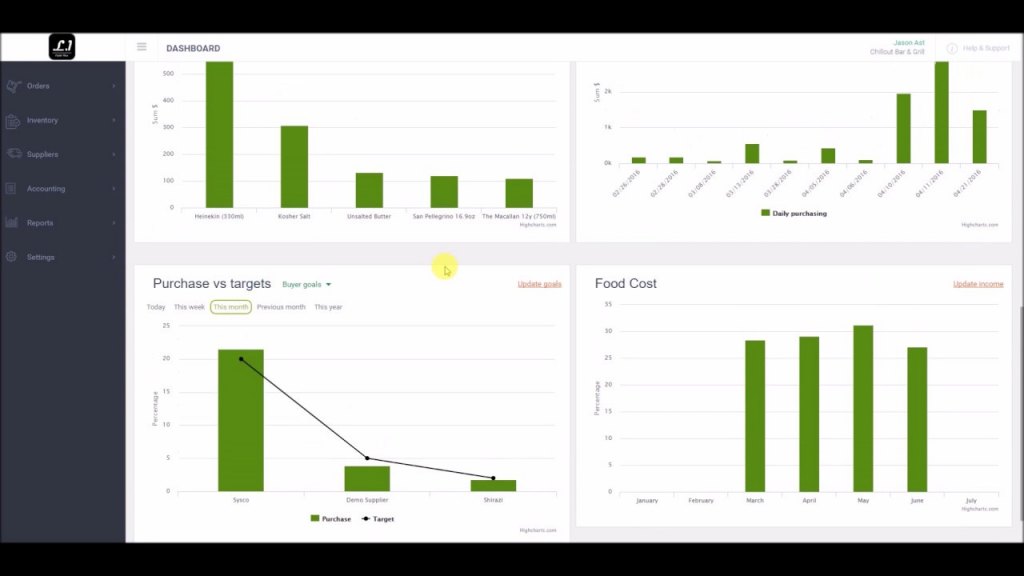
A powerful reporting tool lets users gain insights from their business operations.
How long does it take for an online order to be processed, made by the kitchen staff, expedited for delivery by the office staff, and for delivery vehicles to deliver the food, receive payment, and get back to base? The software can log and track all of these and help you analyze trends and patterns, helping you increase drive-through speed and sales.
7. Pricing and Cost Management
A restaurant’s survival is determined by its long-term profitability, and the key to this is the ability to accurately and quickly perform pricing and costing of your entire operation. A full restaurant audit can identify major costs and how to replace or optimize your menu items.
Deciding when to raise your menu item prices is a tricky thing, but it is necessary as inflation and economic events push prices up even higher. One should increase prices if the market can bear the price increase if consumers are paying for a unique premium menu item that only you offer (they will always be in demand if it is your specialty), or when there is no other way to cut costs.
Menu pricing should be calculated based on what your ideal food cost percentage target is, along with your ideal gross profit margin. Decreasing your ingredient and overall food costs can help you achieve a higher margin and increase your restaurant’s longevity in this highly-competitive industry.
For ghost kitchens or meal preparation parts of the kitchen, scaling up production is also another ideal way to obtain more profit by achieving economies of scale. This may not apply to specialty restaurants or personal chefs, which produce only limited quantities of food at a time, however. Nevertheless, the software can help you in all aspects of pricing and cost management no matter what size your organization is.
8. On-the-Go Access with Mobile App
As MarketMan is fully cloud-based, you can always access all your restaurant data from anywhere through its mobile app. Depending on security authorization, you and your employees can get real-time information about restaurant seating, customer orders, stock inventories, your own customized cookbooks, order and delivery status, current revenue and profit levels, and other relevant information. You can do this while traveling or in the office as long as there is a mobile signal or Internet connectivity through WiFi.

You can set up MarketMan with full security authorization to access features vial mobile.
It has been reported that the software has difficulties in synchronizing data between the cloud back-end and mobile phones, although it is safe to say that user connectivity issues might also be valid causes in these situations. Poor mobile phone signals or WiFi connections will surely affect how quickly data is uploaded and downloaded, so it is more on the user side than on the software or cloud service side. Fortunately, any data input into mobile devices is stored locally until a better connection is found, e.g., when one comes back to the main branch or office.
9. Multi-User and Multi-Location Support
For many restaurants, branches and chains are quite a challenge to manage due to location and distance constraints. Often, problems require supervisors or managers to travel to far branches and perform onsite troubleshooting and staff training. With the help of this software, all data and company SOPs regarding food and menu preparation, finances, operations, and key performance metrics are available to managers anywhere at all times.
Authorized access for staff and workers to information they need can be granted so they can look up recipes, cookbooks, and how-tos to help them in their respective jobs. Essentially, anyone with a smartphone can be empowered with the knowledge they need without onsite visits from managers.
You can quickly standardize operations across branches and provide similar dining experiences at all locations using MarketMan’s cloud services.
10. API Integration with Major Platforms
MarketMan software can integrate well with the software of major food distributors, POS companies, payment and billing systems, and accounting platforms through its robust and simple API. These include integrations with such platforms as Sage, Bill.com, INVU, Intacct, Shopwave, Omnivore, Tavit, Breadcrumb POS, TouchBistro, Aloha, Heartland Xpeint, Square, Toast, Lightspeed, Clover, and many more.
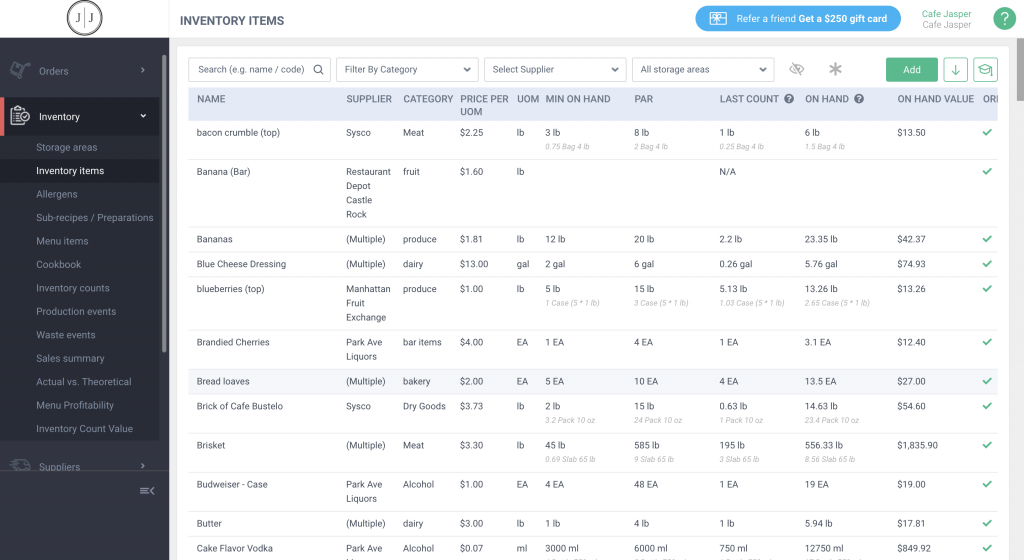
You can easily set up MarketMan to integrate with third-party applications—with Toast, for example here.
Integration with the software your employees are already familiar with or can learn easily is a major plus—you don’t need to hire programmers to set up each of these systems with your platform because MarketMan’s API is easy to access and integrate.
11. Backend Office Management for Suppliers
MarketMan is not only for food and beverage industry institutions and operators, you can also ask your suppliers to use MarketMan to sync your data seamlessly and improve their own operations from their side. With MarketMan, they can achieve digital streamlining through online and mobile ordering, show pricing updates live to you, and offer closeouts and promotions quickly and in real time (food ingredients/items with expiry and best-before dates).
Suppliers can easily manage all incoming orders digitally and centrally and view their customers’ order histories. Integration with their own ERP and accounting systems helps them streamline their operations, giving you a reliable and efficient supplier who uses the same software system as you!
12. Recipe and Ingredients Management
In order to control costs and maintain profitability while still providing excellent dishes to discerning clients, the software provides recipe costing features. This powerful tool presents complete pricing lists and breakdowns for each of your menu’s dishes and calculates those against your revenue and profit per dish.
These data can be sorted and filtered for quick analysis of which ingredients you can replace or get from local and cheaper sources. You can also estimate how much food waste your kitchens produce and plan ways to eliminate them.
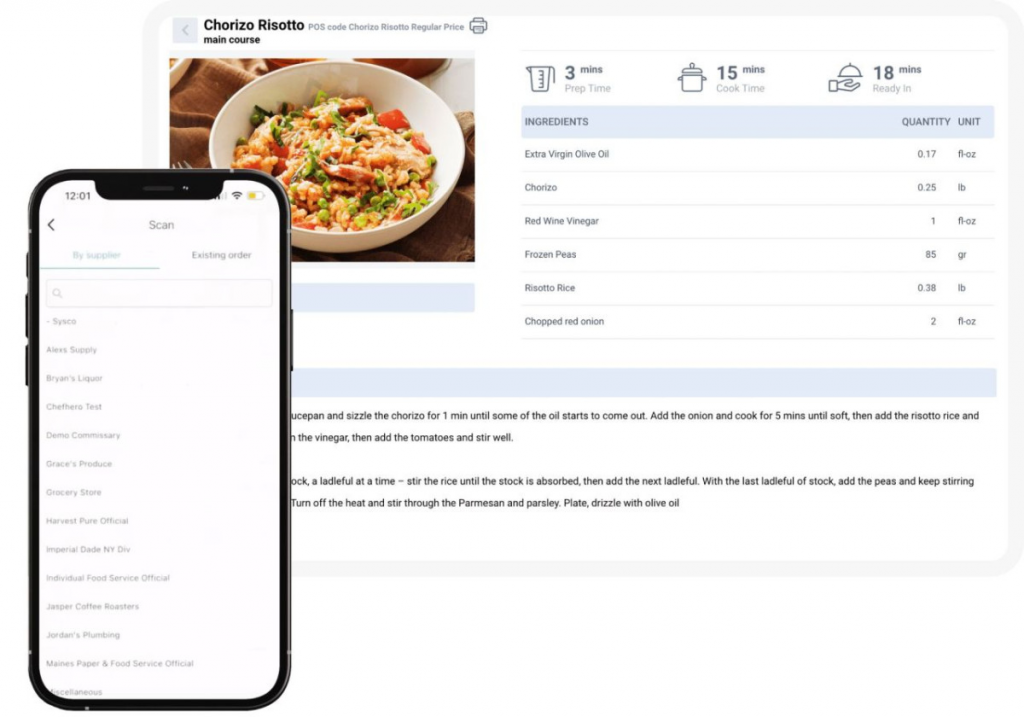
MarketMan provides recipe costing features to control costs and maintain profitability while still providing excellent dishes.
However, for smaller organizations or ghost kitchens with only a few menu items and for those who order fixed amounts of the same ingredients from one or two suppliers, detailed recipe and ingredient management may be in excess of their requirements. They may end up paying too much for features they do not really need.
Also, recipes are closely-guarded secrets that most restaurants may not want to store in any computer system, let alone the cloud. Even disclosing ingredients may also reveal what their recipes contain, so they may not want this feature. They can still use the rest of the software’s functionalities, though.
13. Digital Cookbook
MarketMan’s digital cookbook feature is quite handy and impressive—this feature automatically generates cookbook information with step-by-step instructions on food preparation, portioning, and cooking your menu dishes, complete with photos and prep/cooking time information. This is ideal for training new kitchen staff and planning out new menu items.
This can also help you modify your menu times to incorporate new or cheaper ingredients, improve on older recipes, and streamline time-consuming food prep and cooking time with new technology or equipment.
Restaurant Management Trends
As inflation continues to affect ingredient and food prices, delivery and shipping costs, fuel costs, and all costs related to the food and beverage industry, restaurants have had to come up with more cost-cutting measures by boosting efficiency, relying on economies of scale, outsourcing ingredient prep and delivery services, and choosing cheaper suppliers. However, there is a tipping point where profitability is no longer viable without increasing menu and service prices.
Whether the market can sustain more price increases remains to be seen as many diners opt to stay at home, order food online, or cook their own meals. However, fine dining will always be a premium for high-end customers, and getting more diners from this customer segment will be much more desirable. Commissary kitchens will always have large enterprise-scale customers, and Michelin-star restaurants will always have high-paying customers.
As discussed in this MarketMan pros and cons guide, the software has the key features of restaurant management systems. It can help you become more efficient and cost-effective in all the above aspects. For more detailed information, you can read our full review of MarketMan where its features are described in more detail, including pricing tiers that you can choose from to suit your specific needs.



























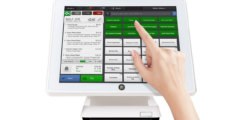



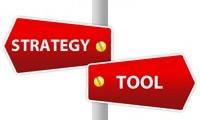
Leave a comment!